An essential occupational therapy tool, the therapy ball helps to work on balance reactions and postural control as well as providing vestibular input in a variety of directions.
In this article, we will talk about how the therapy ball can be used in a variety of ways to provide vestibular input to a child with Sensory Integration Dysfunction
I. BOUNCING
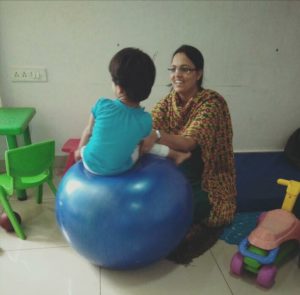
Bouncing ball
-
Gently bouncing a sitting child on the therapy ball offers increased vestibular input. This activity helps to raise a child’s arousal levels when they are feeling sluggish or slow. It brings about eye contact with the person in front of them in addition to alertness and awareness of one’s own body in space.
-
In the same sitting position if the therapy ball is rocked front and back, it enhances the balance and postural control of the child while providing vestibular input.
-
Slow bouncing or slow rocking on the therapy ball for a period (specific to each child) brings about a calming effect on the child. On the other hand, fast bouncing or rocking on the therapy ball brings about alertness in a child.
-
Bouncing can be done in a distraction free environment with rhythmic music or rhyme that enhances the child’s response to his/her surroundings.
-
The duration and frequency of bouncing is specific to each child and must be done according to the advice of an Occupational Therapist, as over-stimulation or under-stimulation of the vestibular sense can have adverse effects on the child. For example, instead of bringing about an optimum arousal level, the child can become hyperactive after the therapy ball activity. Hence, it is always better to consult an OT before incorporating this activity as part of the child’s sensory diet.
II. PRONE LYING POSITION
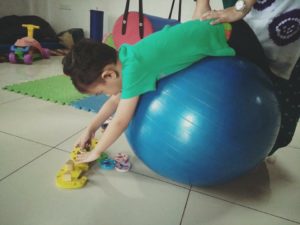
Prone lying position
Here the child lies on his tummy on the therapy ball, wheelbarrow walks out using his hands and reaches for objects in front of him. This position helps to provide maximum vestibular input for a sensory seeker, and good postural control and proximal stability of the joints. It also helps the child to focus on a task for a period of time, thus working on their endurance level. As they bear their own weight through their arms and shoulders, it increases the strength and stability at the shoulder girdle which is very important for developing their fine motor skills like writing.
III. SUPINE LYING POSITION
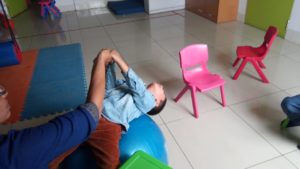
Supine lying position
Here, the child lies with the small of his back on the therapy ball and uses his tummy muscles to pull himself up to reach for an object above them. The sensory input through their arms contributes to increased body awareness, strengthening of core muscles and improving stability and postural strength.
IV. ROLLING BALL
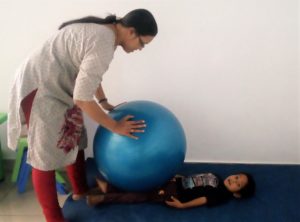
Rolling ball
The child lies on the floor and another person (child or adult) rolls the ball over his/her body. Firm pressure should be applied, but not too hard. You will notice that deep pressure applied in this way will have a calming effect on the child. This can be useful if previous activities have left them excited/ ‘high’ and you need a strategy to help them calm down.
We can help the child develop this activity by getting them to name their body parts as we roll the ball over them on their front and their back
V. SITTING POSITION
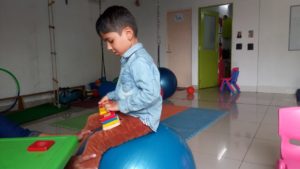
When a child sits on a ball chair, they are able to direct their natural kinesthetic energy and need for movement in a positive way, because the child on a ball chair has to constantly move his body on the chair to maintain his balance. Hence, rather than squash a child's innate need for movement, ball chairs channel their physical energy in a positive way, allowing them to focus on their work more completely and reach their full potential as learners. As a result, they feel less fidgety and more relaxed when they sit on a ball and are able to concentrate more, be it in a classroom or during homework or when having a conversation with others.
VI. SELECTING A THERAPY BALL
The therapy ball is available in assorted sizes and textures, with or with out the handle for support. It would be better to choose an appropriate one according to the mode of use.
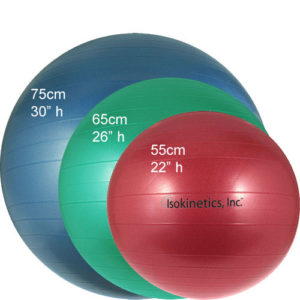
Therapy ball sizes
However, the standardized recommendation is as follows.
| BALL DIAMETER | USER HEIGHT | |
|---|---|---|
| 20-25 cm. ball (8-10 inches) | For non-sitting exercises requiring a small ball | |
| 30 cm. ball (14 inches) | Children 1-2 years old | |
| 42/45 cm. ball (16 inches) | 4 ft. 10 in. tall person | |
| 55/52 cm. ball (21 inches) | 4ft. 11in. to 5ft. 3 in. tall person | |
| 65 cm. ball (25 inches) | 5ft. 4in. to 5ft. 11 in. tall person | |
| 75 cm. ball (29 inches) | 6 ft. tall person & taller |



5 Comments
R. Chitra · August 11, 2018 at 7:58 pm
It is very useful because after long time back i started my profession
M.Arivumathi · April 25, 2019 at 2:25 pm
It’s very useful
priya · October 16, 2019 at 3:45 pm
Thank you for sharing the information about ball therapy
tsholofelo setshedi · September 23, 2020 at 12:38 am
This was beyond helpful. I am from South Africa and a final year student, this was such helpful and precise information. Thank You!
Ummu Habeeba · December 16, 2021 at 10:22 pm
Thank you ma’am sharing this information and it is very useful